Guides & Tips
Want to improve your home's efficiency, learn about HomeServe protection plans or what equipment is your responsibility?
Aqua can help. Our experts are here to inform and help to make sure your systems are running as safely and sustainably as possible.
And, whether you're a renter or homeowner, it's important to know which parts of your water or wastewater system are your responsibility, and information around how to help protect some of your home systems if necessary. Let's dive in.
Division of Responsibilities
Much of the equipment we use to provide water and wastewater services is located beneath the ground, and it can be difficult for customers to determine what equipment is their responsibility and what equipment is Aqua’s responsibility. The following water and wastewater diagrams and descriptions help explain the equipment used to provide service and ownership clarification.
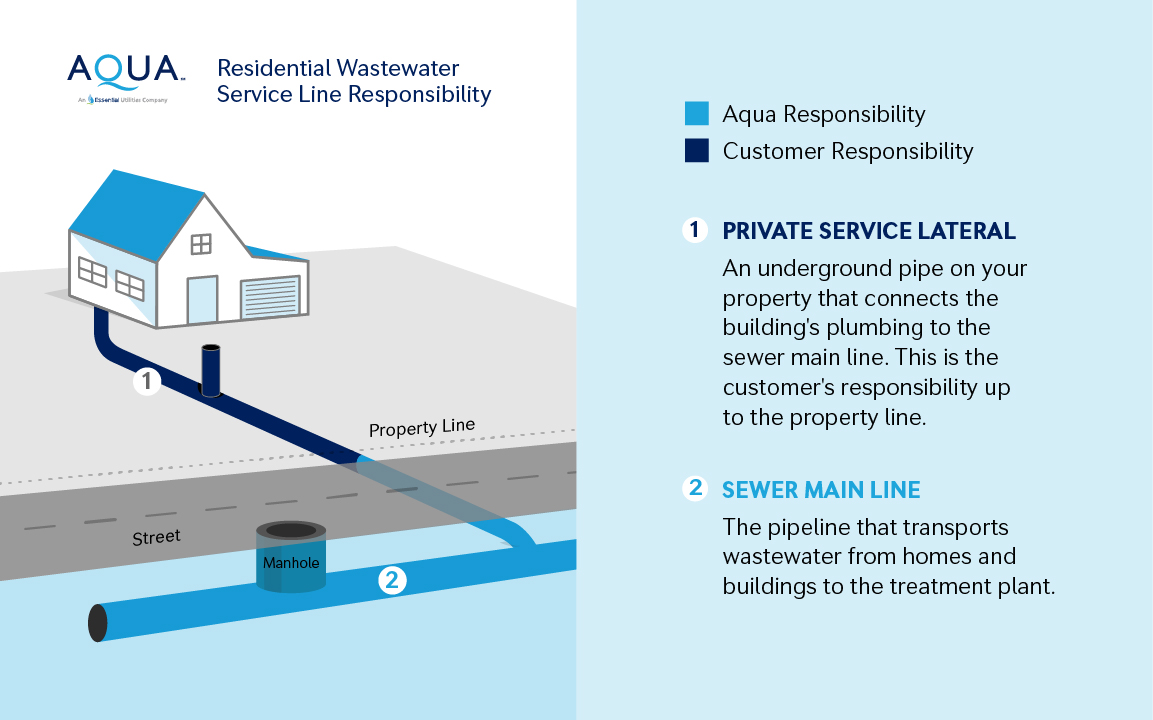
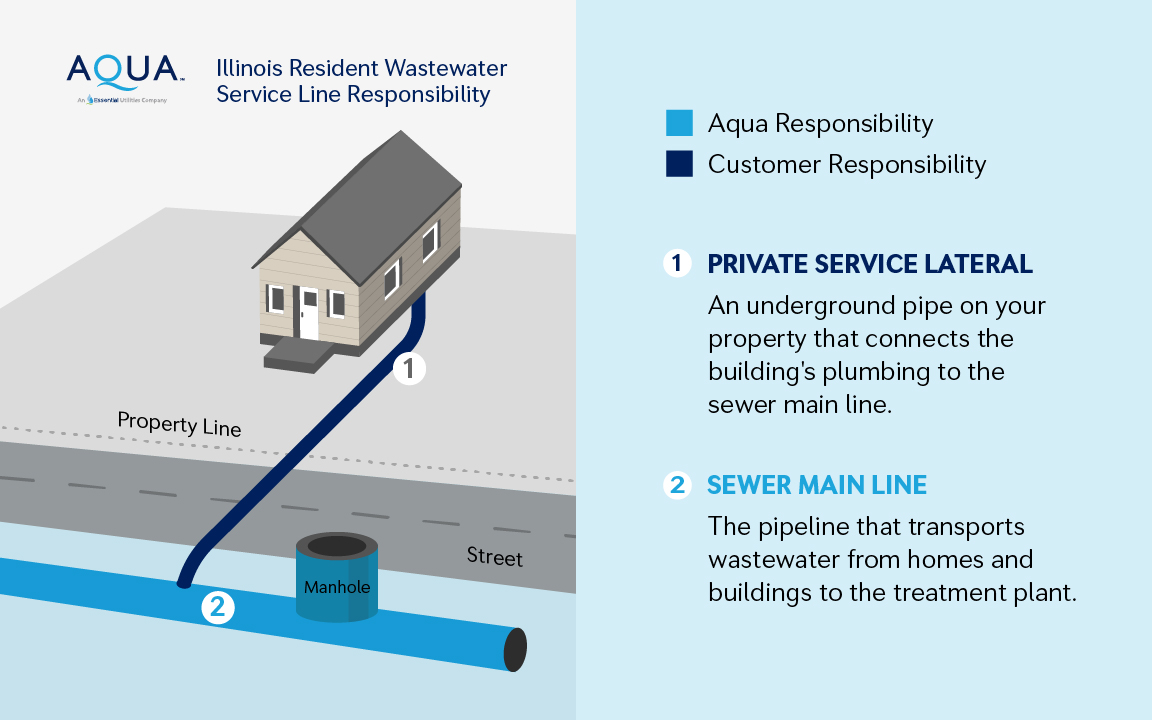
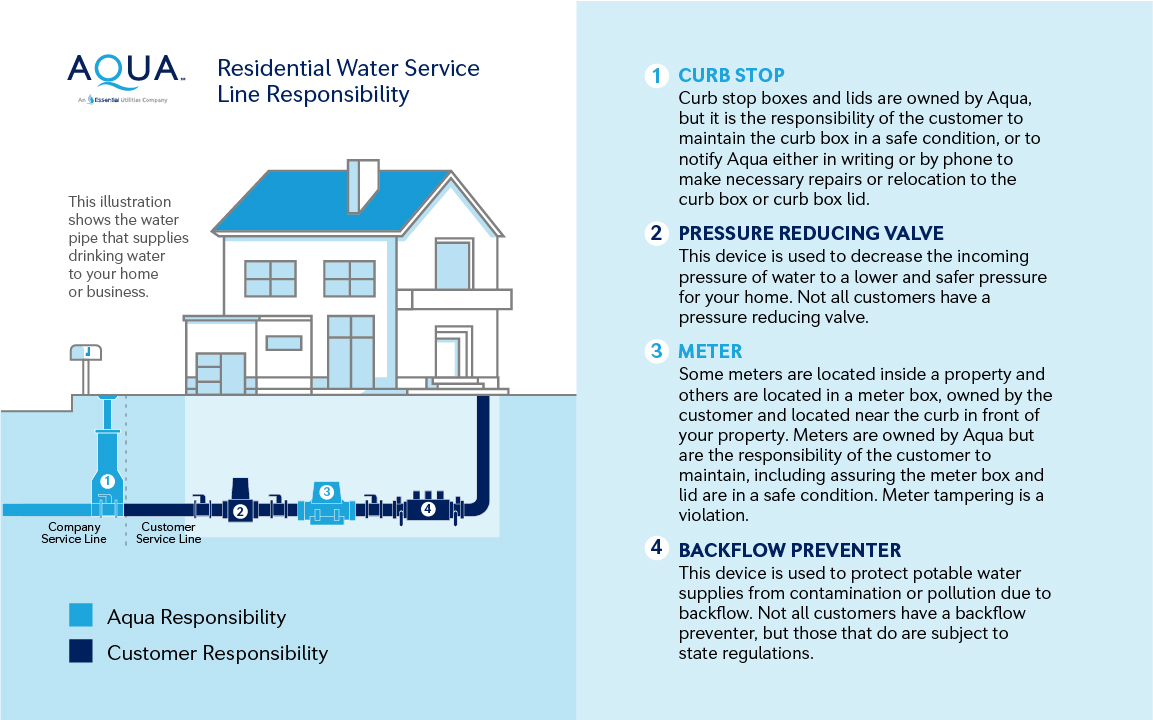
Equipment Descriptions
Backflow Preventer
Customer owned. When installed, this device is designed to prevent a potential backflow of contaminants from the customer’s property into the company’s distribution system.
Curb Stop
Owned and maintained by the company, the curb stop is a valve that can be opened and closed to control the supply of water to the property.
Company Service Lines
Owned and maintained by the company, this service line extends from the water main to the curb stop or curb line.
Customer Service Line
Owned and maintained by the customer, this service line extends from the curb stop or curb line to the building.
Pressure Reducing Valve (PRV)
Owned, installed and maintained by the customer, this device is designed to reduce water pressure within the customer’s home if the pressure of the company’s distribution system exceeds a certain threshold set by the plumbing code (typically 60 pounds per square inch). Installing a PRV might increase the life of internal plumbing fixtures and piping. A plumber can verify the pressure in your home and determine whether a PRV should be installed as part of your household plumbing.
Meter and Meter Pit
Meter: Owned and installed by the company, this device is used to measure water consumption at the customer’s property. Although the meter is owned by the company, the customer is responsible for providing an adequate location for the meter, making it accessible and assuring that it is protected from damage, including damage caused by freezing.
Meter Pit: Owned and maintained by the customer, this structure is constructed by, or for, the customer to house the water meter outside of the customer’s home at an underground location. Customers are responsible for keeping the pit visible and for all the plumbing within the pit. The illustration above titled "Residential Water Service Line Responsibility" shows a meter in the home, so the meter pit is not shown.
Tips & Tricks for Better Efficiency, Protection & Maintenance
Don't Leave the Water Running
Don't leave the tap running when shaving or brushing your teeth. You can waste up to five gallons of water! If shaving, fill the sink with a few inches of water and use that to rinse your razor instead.
Also, don't always use the tap for drinking water. Keep a pitcher of drinking water in the refrigerator. It's easy to let the faucet run until the water is cool every time you fill a glass, which adds up!
Cooking Tips to Conserve Water
Cook food in as little water as possible. As a bonus, you'll also retain more nutrients in the food so your meals are healthier and tastier.
Don't use hot water to thaw frozen food. Think ahead, and leave frozen foods in the fridge overnight. It saves water, and it's safer, too.
Showers Are More Efficient than Baths
A full bathtub can use around 40 gallons of water while a 10-minute shower uses half that. The quicker you shower, the more water you can conserve! By shortening your shower by just a minute or two, you can save up to 150 gallons per month.
Upgrade or Retrofit Your Toilet
Upgrade to a dual-flush model or buy a dual-flush handle kit for your existing toilet. A new dual-flush model can use less than one gallon compared to up to five gallons for older models. If you have an older model and can't update it, simply place a full water bottle in the tank. Each time you flush, you'll use that much less water.
Don't Flush Trash or Wipes
Use your trash can for trash such as tissues and non-flushable wipes instead of the toilet. Each flush uses up to five gallons of water. And flushing the wrong things can cause backups in your household plumbing and problems in wastewater collection systems. Even wipes marketed as being “flushable” don’t break down fully. Please dispose in the trash instead of flushing.
Check for Leaks
Check for leaks (both inside and out). Even a small drip can waste up to 140 gallons a week! Fixing the problem is usually pretty straightforward.
Conduct a water audit. Set aside a two-hour window when your water isn't being used at all. Check the water meter before and after that two-hour period. If the meter changes, you likely have a leak.
Buy High-Efficiency Appliances and Products
Install a high-efficiency washing machine and use 50% less water. You'll save a good amount of energy, too. Also look for products that have the WaterSense label. They're more efficient and can provide significant water savings.
Cut Back on Rinsing Dishes
Scrape the food off and let the dishwasher do the rest. Newer models are quite thorough. Also, soak pots and pans instead of letting the water run while you scrape them clean.
Source Water Protection
Source water protection is the first barrier against contamination of public water supplies. Protecting the sources of our drinking water helps to reduce public health risks and control water treatment costs, among other benefits to communities and the environment. Click the image below to view larger.
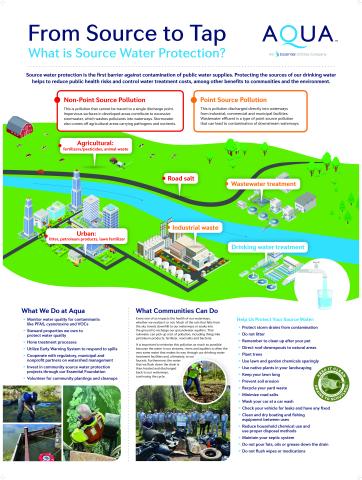
Protect Your Sewer (from fats, oils, and greases)
Fats, oils and greases are no friend to your sewer system. In fact, they can be quite harmful.
Sewer overflows and backups can cause health hazards, damage home interiors and threaten the environment. An increasingly common cause of overflows is sewer pipes blocked by grease.
Grease gets into the sewer from household drains as well as from poorly maintained grease traps in restaurants and other businesses. But helping to prevent sewer overflows and backups is easy.
Where does the grease come from?
A byproduct of cooking, grease comes from meat fats, lard, oils, shortening, butter, margarine, food scraps, baking goods, sauces and dairy products. When washed down the sink, grease sticks to the insides of sewer pipes on your property and in the streets. Over time, it can build up and block the entire pipe.
Beware: Home garbage disposals do not keep grease out of the plumbing system. Products such as detergents that claim to dissolve grease might pass it down the line and cause problems elsewhere, possibly resulting in the following:
- The overflow of raw sewage in your home or your neighbor’s home.
- An expensive and unpleasant cleanup that often must be paid for by you, the homeowner or business owner.
- The overflow of raw sewage into parks, yards and streets.
- Potential contact with disease-causing organisms.
- An increase in operation and maintenance costs for local sewer departments, which causes higher sewer bills for customers.
What can I do?
The following are ways you can help prevent sewer overflows:
- Never pour grease down sink drains or into toilets.
- Scrape grease and food scraps into a can or the trash for disposal for recycling (where available).
- Put baskets/strainers in sink drains to catch food scraps and other solids, and empty them into the trash.
- Talk with your friends and neighbors about how to keep grease out of sewers.
What do business owners need to know?
For a grease trap or interceptor to work correctly, it must be:
- Designed, sized and manufactured to handle the amount that is expected
- Installed properly – must be level and vented
- Maintained regularly – cleaned and serviced on a frequent basis
Solids should never be put into grease traps or interceptors. Routine daily maintenance of grease traps and interceptors is necessary.
Information adapted from the Water Environment Federation.
Prevent Frozen Pipes
Winter weather and cold temperatures can wreak havoc on household plumbing. As the homeowner, you are responsible for the protection of your home’s pipes and meters and for any damage to them.
Pipes and meters are located against exterior walls or often in unheated basements or crawlspaces, leaving them vulnerable to freezing temperatures. In freezing temperatures, metal pipes contract as the water inside expands. This is what causes pipes to burst.
Below are tips that will help you protect yourself from costly plumbing repairs.
- Insulate pipes. Be sure to insulate pipes in any unheated areas of your home. One way to insulate your pipes is using heat tape or pipe insulation. These items can be purchased at a local home improvement store.
- Protect your water meter. If you have an outdoor meter pit, make sure the lid is not broken or missing. Pack the pit with insulating material, or even an old blanket. Be sure you are insulating your water meter, not your gas meter! Gas meters should never be wrapped or insulated; they require open air around them to function properly.
- Eliminate drafts. Close off crawlspace vents and doors. Repair broken or cracked basement windows. Make sure basement doors and windows close tightly.
- If temperatures drop to close to 10 degrees Fahrenheit, be sure to do the following:
- Check the water temperature by placing a thermometer under the tap.
- Leave a very thin stream of water running constantly from at least one tap. We recommend using the tap farthest from the meter. The additional expense in your water bill will be minimal compared to the cost to replace a ruptured pipe.
- Open cabinet doors below all sinks to allow the warmth from inside your house to reach your pipes. Before you follow this tip, be sure to remove all harmful items from beneath the sink.
Place this information on your refrigerator during the winter. Following these tips can save you a great deal of money.
Remember, you are responsible for the pipes inside your home.
Water Heater Maintenance
If you’ve been away from your home for a long time, you might want to check your water heater when you return.
Manufacturers recommend periodically flushing sediment from your storage-type water heater. Residents in areas with high mineral content in the water should flush more often.
Most sediment in water heaters develops when minerals settle after the water heats. Sediment in water heaters also can contain sulfur compounds that can cause odors in the water.
Here’s how you can flush sediment from a water heater:
- Be cautious — the water in the heater might be extremely hot and capable of causing burns.
- Follow the manufacturer’s instructions for specific procedures on how to flush the water heater. These instructions are generally found in the manual included when the heater was purchased. You might also find them on the manufacturer’s website. If you are unable to find the manual or information on the website, the following procedures may work for you.
- If you have a gas water heater, set the gas valve to "pilot" to prevent the burners from coming on while you are flushing it. If you have an electric water heater, be sure to turn off the circuit breakers to the heater. If the water level drops below the heating elements and the thermostat turns them on, the heating elements could be damaged.
- Connect a garden hose to the drain valve at the bottom of the tank. Be sure to run the hose to a safe outdoor area where the water will not seep or pool. The water could be very hot — make sure the outlet of the hose is in a safe area away from pets and children.
- Close the shut off valve on the cold water inlet to the water heater.
- Carefully open the temperature/pressure-relief valve at the top of the tank by lifting the lever. Leave the valve open.
- Open the drain valve at the bottom of the heater to allow the water to flow out through the garden hose. If sediment is clogging the drain valve, try closing the temperature/pressure-relief valve and turn the cold inlet valve back on to “power-flush” the sediment.
- In some cases, the sediment hardens into large chunks that can block the drain valve. If this occurs, wait until the water in the heater has cooled, remove the garden hose from the drain valve, remove the valve if necessary, and use a long screwdriver to break up the clog.
- When the garden hose runs clear, you’re finished.
- Close the drain valve at the bottom of the tank and remove the garden hose.
- Close the pressure-relief valve at the top of the tank if it is still open, and open the hot water faucets in the highest part of the house. Slowly turn on the cold inlet valve for the hot water.
- Let the hot water faucets run in the house until the air bubbles stop coming out, then fully open the cold water valve to the hot water heater. Make sure your pressure relief valve and drain valve aren't leaking.
- Turn the heater back on. With a gas heater, relight the pilot light if it has gone out.
Grinder Pump Maintenance
A household-pump system, also known as a grinder-pump system, is a mini sewage pumping station with one pump for individual houses. Grinder pumps are used where gravity sewer lines cannot be used. The single pump sits inside an underground tank and pumps wastewater produced in your home into the sewer line.
How does it work?
A single pump is placed in a tank that is buried in a convenient outdoor location on your property. The tank provides a small amount of wastewater storage capacity. When water is used in the house, wastewater flows into the tank. When the wastewater in the tank reaches a preset level, the pump automatically turns on and pumps the waste out of the tank to the wastewater treatment plant. The pump will normally run for a few minutes and automatically shut off when the tank is emptied. The pump is connected to a control panel usually located on the side of the house.
How do I protect my pump system?
A properly maintained pump system should be able to handle typical wastewater from your kitchen, bathrooms or laundry. Some chemicals and materials might cause operating problems and safety hazards. It is advisable to check labels on chemicals prior to their disposal.
Never put any of the following materials into sinks, toilets or drains:
- Glass, metal, wood, seafood shells
- Papers, socks, rags or cloth of any kind
- Plastic objects (toys, eating utensils, etc.)
- Any strong chemical, toxic, caustic, or poisonous substance
- Degreasing solvents
- Any explosive or flammable material
- Lubricating oil grease
- Cooking fat (lard, oil, grease)
- Hair clippings or dental floss
- Clean up wipes or any non-biodegradable material
- Kitty litter or aquarium gravel
These items can damage the pump system and its controls, and can cause blockages or backups. These items might also create unsafe conditions in the lines and tank, and might damage the environment.
When installing landscaping, please do not plant trees or shrubs around or near the household pump station. There must be enough space to work on the pump station when necessary. Also, never attempt to open the tank cover or the electrical panel box.
What do I do if the power fails?
If there is a power failure at your home, your pump system will not operate until the power is restored. The pump tank has a small amount of holding capacity, but interior water use should be minimized until power has been restored as continued usage might create a backup and/or a spill.
What do I do if the alarm sounds?
If there is a pump system failure, the tank containing the pump will become too full. An audible alarm and light located in the alarm box on the outside of your home will automatically turn on. If this happens, you should discontinue water use to prevent overflows and backups. To silence the alarm (or if the light is on), please contact Aqua.
I’m going on vacation, how do I protect my pump?
If you plan to be away from home for more than seven days, we suggest the following steps be taken to ensure the proper operation of the system:
- First, run water from an inside tap long enough for the pump system to begin working.
- After the pump turns on, turn the water off. The pump will run until the tank is empty and will shut off.
This process will clean the pump and leave it filled with a minimum of clean water. Always leave the electrical power on.
By following these guidelines, you can ensure that your household pump system will provide many years of safe, reliable service.
Locate the Water Master Valve
Locate the Water Master Valve
What is the Water Master Valve?
The water master valve is a crucial component of your property’s plumbing system, typically located near your water meter or where the main water line enters your home. It controls the flow of water throughout the property.
Check if Water Master Valve is Turned On or Off
Step 1: Locate the Water Master Valve.
Common locations include:
- Near the water meter
- In the basement or crawlspace
- Where the water supply pipe enters your home
- Near the water heater
- Outside near the foundation of your home
Step 2: Inspect the Water Master Valve Handle.
There are 2 types of water master valves (gate or ball). Determine which one you have based on the images provided:
Gate Valve | Ball Valve |
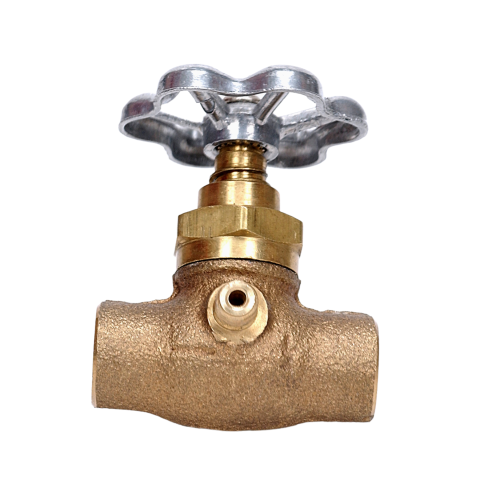
| 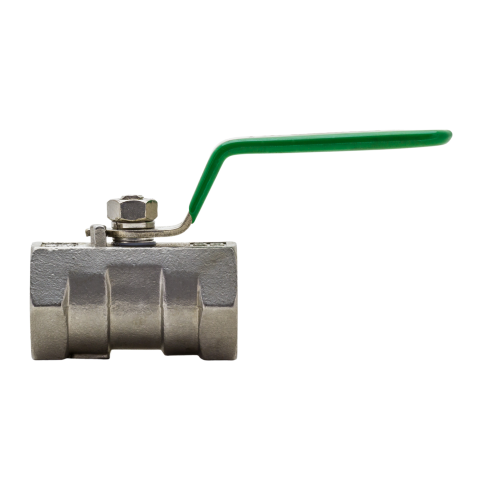
|
Step 3: Determine the Open/Close Position and Adjust if Necessary.
If Open, water should be on. if Closed, water should be off.
Gate Valve
- Open: Handle is turned completely to the left
- Closed: Handle is turned completely to the right
Ball Valve
- Open: Lever is parallel to the pipe
- Closed: Lever is perpendicular to the pipe
See the above information formatted as a PDF here (and pasted below).

Outside the Home Conservation Tips
Don't water the yard during the day. Water the lawn, plants and flowers in the morning or late evening when it's cooler, and never water when it's windy. You'll lose a lot of water because of evaporation from heat and wind.
Don't use too much fertilizer. While fertilizers help plants grow, they also increase water consumption. Apply the minimum amount of fertilizer needed.
Mulch, mulch, mulch! Use at least two inches of organic mulch around plants to reduce evaporation. Based on the size of your garden, you could save hundreds of gallons of water a year.
Minimize water use and save time by xeriscaping. Xeriscaping is a style of gardening and landscaping that focuses on minimizing water use. Start with drought-resistant lawns, shrubs and plants, and you can save tons of water and time.
Keep your water in the pool. Don't overfill the pool. Lower water levels will reduce water loss from splashing.
Identifying Aqua Employees
Protect yourself from imposters by properly identifying Aqua employees
At Aqua, our top priority is to provide clean, safe, reliable water and wastewater services to our customers. We also want to protect our customers from imposters by helping properly identify Aqua employees.
When will Aqua visit my home?
Typically Aqua will need to gain access to your home for service or to exchange a meter, or to respond to a problem you’re aware of ahead of time. In most instances, we’ll schedule an appointment and you’ll know to expect us.
There are a few instances in which Aqua employees could make an unannounced visit:
- We could visit to make you aware of an unscheduled service outage, such as a main break. In this case, the employee would not need to access the inside of your home.
- We could make an unannounced visit to investigate a property that has had multiple "zero usage" bills or an account that has not had a meter read for more than 45 days. In these cases, the employee would have an Aqua photo identification card.
- If a meter reader has trouble getting remote meter read from outside your home, an employee might ask to enter you home to read the meter, in which case they would present their photo identification card.
Regardless of if the appointment is scheduled or unannounced, we always want you to confirm the person who comes to your property is an Aqua representative.
How do I identify an Aqua employee?
Here’s how you can spot an Aqua employee:
- They drive company vehicles (mostly white Chevrolets) with the Aqua logo
- They are dressed in company uniforms with the Aqua logo
- They carry photo identification with the Aqua logo.
Employees should introduce themselves to the property owner and voluntarily present their photo identification cards. In a rare instance an employee doesn’t share an ID card, you should ask to see it.
If you are ever uncomfortable with the person who comes to your door or the reason they give you for the visit, please call our customer service team at 877.987.2782 to have both the visit and the name of the employee confirmed before allowing entry to your home.
At Aqua, our customers' safety is our top priority. Contact our customer service team at 877.987.2782 for more information.
Protection Plans from HomeServe
The water and sewer service lines on your property are your financial responsibility, and they can fail unexpectedly. Aqua partners with HomeServe so we can offer our customers protection from the cost and inconvenience of dealing with unexpected line repairs.
Customer's Water Line Responsibility
The Customer Service Line and Meter Pit are owned and maintained by you, the customer:
- Customer Service Line: Extends from the curb stop or curb line to the building.
- Meter Pit: Houses the water meter outside of the customer's home at an underground location. Customers are responsible for keeping the pit visible and for all plumbing within the pit.
Why Should You Protect Your Lines?
When water and sewer service lines fail, repairs will require time and money. Protection Plans from HomeServe were created to take care of customers when the unexpected happens. Coverage will provide you peace of mind knowing:
- You'll be able to call to schedule a repair
- Covered repairs or replacements to your lines are included (coverage is based on the program you enroll in).
- Work is completed by a qualified professional from the HomeServe network.
More on the Protections Plans from HomeServe can be found here.
Coverage subject to eligibility requirements, exclusions, waiting period and terms and conditions. For additional information and/or to sign up online, call 888.666.7711 or visit homeserve.com.
HomeServe USA Repair Management Corp. ("HomeServe") is an independent company separate from Essential Utilities and Aqua subsidiaries and offers optional service plans. Essential Utilities has a partnership with HomeServe to offer these optional service plans to Aqua’s customers for a fee; however, the regulated Aqua subsidiaries do not endorse and are not partners with HomeServe. Your choice of whether to purchase this optional plan will not affect the price, availability, or terms of service from Aqua. Furthermore, failure to pay for these optional service plans will not result in termination of utility service. Aqua customers might also be contacted by other companies offering the same optional service plans and may enroll in their service plans.
Want to Hear More?
Please fill out the form below, and one of our representatives will connect you with a HomeServe representative. For additional information and/or to sign up online, visit homeserve.com.
